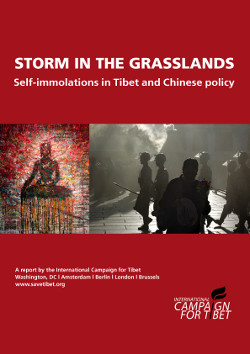 Since February 2009, 94 Tibetans have self-immolated in Tibet, with a dramatic acceleration in frequency since the once-in-a-decade leadership transition at the Chinese Communist Party Congress in November. Twenty-eight Tibetans self-immolated in November alone, marking a new phase in the political struggle in Tibet. Many acts of self-immolation – that have recently been clustered in politically restive areas of Amdo in eastern Tibet – have been followed by mass gatherings of Tibetans to honor and express solidarity with those who have called for freedom for Tibet and the return of the Dalai Lama as they set themselves on fire.
Since February 2009, 94 Tibetans have self-immolated in Tibet, with a dramatic acceleration in frequency since the once-in-a-decade leadership transition at the Chinese Communist Party Congress in November. Twenty-eight Tibetans self-immolated in November alone, marking a new phase in the political struggle in Tibet. Many acts of self-immolation – that have recently been clustered in politically restive areas of Amdo in eastern Tibet – have been followed by mass gatherings of Tibetans to honor and express solidarity with those who have called for freedom for Tibet and the return of the Dalai Lama as they set themselves on fire.
ICT’s new publication ‘Storm in the Grasslands: Self-immolations in Tibet and Chinese policy’, reports that an almost daily frequency of self-immolations in recent weeks demonstrates a strong resolve among Tibetans to compel the new Chinese leadership to confront the policies and oppression that are the causes of these acts.
Click here to download PDF report.
‘Storm in the Grasslands: Self-immolations in Tibet and Chinese policy’ reports:
- New evidence of the motivations for self-immolation through the statements and last conversations of Tibetans who self-immolated. Mostly their communication has been addressed to fellow Tibetans, as opposed to the Chinese authorities or the international community, and they call for life-affirming actions of protecting Tibetan cultural identity and connecting to each other as a way of determining their own destiny.
- The Chinese government has responded to the self-immolations and unrest in Tibet by intensifying the military buildup and strengthening the very policies and approaches that are the root cause of the acts, such as aggressive campaigns against loyalty to the Dalai Lama. The Chinese Communist Party’s feared erosion of authority and criminalization of self-immolation also leads to retributive actions against families, relatives, or monasteries associated with those who have self-immolated, which creates a vicious spiral in which more people are prepared to self-immolate because of the oppressive conditions.
- While the self-immolations are deeply controversial, the overwhelming response from Tibetans to those who self-immolate is one of respect and the authorities’ attempts to turn people against them has been a resounding failure. Thousands of Tibetans have gathered to pray and pay their respects for those who have self-immolated, and peaceful protests involving Tibetans from all sectors of society – schoolchildren, students, nomads, herders, teachers – have often followed the self-immolations. The responses by Tibetans across Tibet to the self-immolations indicate both the significance of the actions as statements, strong solidarity and unity among Tibetans, and an alternate narrative of cultural resilience as Tibetans take increasingly bold steps to defend the core values of their culture.
- Tibetans have sought to demonstrate their allegiance to the Dalai Lama’s ethos of non-violence, and ICT’s report includes images of symbolic expressions of non-violent intent in which Tibetans hand in knives to be destroyed along with wild animal pelts, in gestures that illustrate vows to end internal strife and stay united. There are still fears, however, of how the political struggle in Tibet may develop if Chinese oppression continues.
- While the Chinese government has sought to underplay the self-immolations, they expose a crisis in the Beijing leadership’s Tibet policy. The self-immolations are a dramatic and visible counter to the claims of the Chinese Communist Party to be improving Tibetans’ lives and they are a direct challenge to the Party’s legitimacy in Tibet. Although the Chinese government has sought to blame the Dalai Lama and ‘outside forces’ for the self-immolations, It is acknowledged by the international community as well as a number of scholars and netizens in China that these dramatic developments in Tibet reflect significant failures in policy that must be addressed.
‘Storm in the Grasslands: Self-immolations in Tibet and Chinese policy’ includes:
- Details about the lives of 58 Tibetans who have set fire to themselves, including translated copies of notes they left behind or details of their last words to friends and family.
- Analysis of a direct correlation between the self-immolations and an intensified campaign against the Dalai Lama in Tibet together with the aggressive expansion of legal measures tightening state control over Tibetan religion and culture.
- Insights from work team officials in Tibet of the authorities’ new ‘war against secessionist sabotage’, in which the Chinese government seeks to replace loyalty to the Dalai Lama in Tibetan hearts and minds with allegiance to the Chinese Communist Party and undermine Tibetan national identity.
- An assessment of the official response to the self-immolations. As the scale of the tragedy increased, there appeared to be a level of ambiguity in official reporting, although language became more strident particularly at the time of the Communist Party Congress in November, when self-immolations spiked in Tibet.